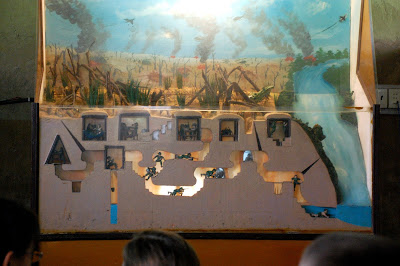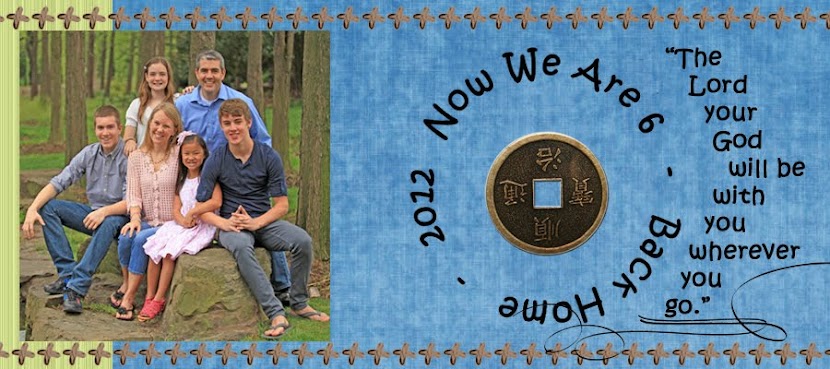 The intricate system of tunnels, several stories deep, included innumerable trap doors, living areas, storage facilities, weapons factories, field hospitals and kitchens. The tunnels allowed the Viet Cong to mount surprise attacks wherever the tunnels went, which was even within the perimeter of the US military base, and then disappear suddenly into hidden trapdoors without a trace.
The intricate system of tunnels, several stories deep, included innumerable trap doors, living areas, storage facilities, weapons factories, field hospitals and kitchens. The tunnels allowed the Viet Cong to mount surprise attacks wherever the tunnels went, which was even within the perimeter of the US military base, and then disappear suddenly into hidden trapdoors without a trace.Here Seth is disappearing "without a trace", lowering the trapdoor covered with leaves on top of himself.
 After the other kids have had a chance to stand on the trapdoor with Seth safely inside the tunnel, he reappeared. Of course all the kids wanted to try getting in this little tunnel opening.
After the other kids have had a chance to stand on the trapdoor with Seth safely inside the tunnel, he reappeared. Of course all the kids wanted to try getting in this little tunnel opening. Gwen wanted to try it too, and did, but wasn't too pleased when her brother put the trapdoor over her, leaving her in the dark. He quickly rescued her, though!
Gwen wanted to try it too, and did, but wasn't too pleased when her brother put the trapdoor over her, leaving her in the dark. He quickly rescued her, though! The American troops in the war were unaware of the tunnel system for a long time, and used various methods, including large scale ground operations with tens of thousands of troops to scour the jungles and chemical defoliants to clear the area of trees and undergrowth. Eventually they found the tunnels and sent men down into them, but the casualty rate for Americans in the tunnels was extremely high. They also used dogs to sniff out trapdoors and guerrilla soldiers. The dogs were not able to avoid the many booby traps the Viet Cong set throughout the tunnel area, and many dogs were killed or injured.
The American troops in the war were unaware of the tunnel system for a long time, and used various methods, including large scale ground operations with tens of thousands of troops to scour the jungles and chemical defoliants to clear the area of trees and undergrowth. Eventually they found the tunnels and sent men down into them, but the casualty rate for Americans in the tunnels was extremely high. They also used dogs to sniff out trapdoors and guerrilla soldiers. The dogs were not able to avoid the many booby traps the Viet Cong set throughout the tunnel area, and many dogs were killed or injured.In these two photos we're checking out one of the booby traps. It is a rotating platform, with greenery on both sides to disguise it.
 Not a happy landing if you ended up in this trap.
Not a happy landing if you ended up in this trap. Finally the USA declared the Cu Chi tunnel area a free-strike zone, meaning little authorization was need to shoot at anything in the area. In the late 1960's, American B-52s bombed the whole area, destroying most of the tunnels and everything else around.
Finally the USA declared the Cu Chi tunnel area a free-strike zone, meaning little authorization was need to shoot at anything in the area. In the late 1960's, American B-52s bombed the whole area, destroying most of the tunnels and everything else around.The kids are standing in a B-52 bomb crater.
 There was shooting range at the tunnel site, so all the boys took turns shooting a variety of Vietnam War era weapons at targets that really were paper tigers.
There was shooting range at the tunnel site, so all the boys took turns shooting a variety of Vietnam War era weapons at targets that really were paper tigers.
 Our whole crew of five families, posing on a US tank.
Our whole crew of five families, posing on a US tank. Entrance to a tunnel... want to wiggle in past that root?
Entrance to a tunnel... want to wiggle in past that root? Gwen is heading through a tunnel! The tunnels were all carved out of the clay by hand, over a period of many years. Of course these tunnels have been made a bit more comfortable for visitors to get through than they originally were. Even so, Gwen had to crouch down, and in some places, we were on our hands and knees.
Gwen is heading through a tunnel! The tunnels were all carved out of the clay by hand, over a period of many years. Of course these tunnels have been made a bit more comfortable for visitors to get through than they originally were. Even so, Gwen had to crouch down, and in some places, we were on our hands and knees. Emerging into the sunlight!
Emerging into the sunlight! Checking out some Viet Cong soldier models, seated on the ground in uniform. Looks like our little friend Jason, next to Gwen, has his own stick gun. :-)
Checking out some Viet Cong soldier models, seated on the ground in uniform. Looks like our little friend Jason, next to Gwen, has his own stick gun. :-) Scott and Rich checking in on work emails at the tunnel site... Singapore and London don't celebrate China's National Day holiday!
Scott and Rich checking in on work emails at the tunnel site... Singapore and London don't celebrate China's National Day holiday! At the end of the tour, we were given a chance to taste tapioca. No, it's not the pudding your grandmother made, but the root vegetable which I understand is also called cassava. The starch from cassava is what tapioca pudding is made from. It was boiled, I guess, and there was a sweet and salty spice mixture we dipped it in. Apparently this was one of the foods the tunnel dwelling peasant soldiers lived on during the Vietnam War.
At the end of the tour, we were given a chance to taste tapioca. No, it's not the pudding your grandmother made, but the root vegetable which I understand is also called cassava. The starch from cassava is what tapioca pudding is made from. It was boiled, I guess, and there was a sweet and salty spice mixture we dipped it in. Apparently this was one of the foods the tunnel dwelling peasant soldiers lived on during the Vietnam War.




No comments:
Post a Comment